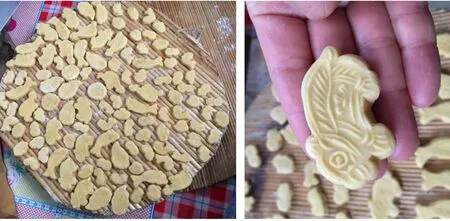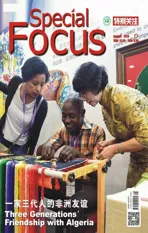Traditions and Customs of Qixi
2018-08-31

1.Spider web and needle shadows
In the Han Dynasty, girls would place a small spider in a small box. The density of the web indicated the skillfulness of a girl.In the Tang Dynasty, the spider was placed on a melon. In the Song and Yuan Dynasties, the shadow of a needle on the water’s surface was the indicator. These tricks are all tests of embroidery skills.
2.Worshiping the Girl Weaver
As for the ceremony worshiping the Girl Weaver, girls and young ladies would make appointments with their friends and neighbors in advance. They would put a table out under the moonlight with tea, white wine, five kinds of seeds and fruits (longan, red dates, hazelnuts, peanuts, and sunflower seeds). In addition,there would be a bunch of flowers wrapped in red paper in a bottle,and in front of the flowers would be a small incense burner. The young ladies and girls would fast for one day and have a bath. After the worship, everyone sat around the table, eating, chattering,and praying silently to the Girl Weaver. The girls wished to be more beautiful or marry a good man, and the young ladies wished to have a baby and a happy family.
3.Making and eating Qiaoguo
Qiaoguo, also named Qiqiao fruit,has many patterns. Its ingredients are oil, flour, sugar, and honey.InReminiscences of the Eastern Capital, a notebook about city life in the Song Dynasty, Qiaoguo is called “Xiaoyan’er” and“Guoshihuayang.” During the Song Dynasty, Qiaoguo could be bought in the market.
Cooking method: first, heat the sugar into liquid; mix it with the flour, and add the sesame;properly mix them in and spread the dough on the chopping board.When it is cold, cut the dough into long cubes, and shape it into a fusiform. Finally fry it in the pot, and then the Qiaoguo is made. Fried flour-made dough in a variety of shapes are also known as Qiaoguo.
In addition, there can be many varieties of fruits presented in the Qiqiao ceremony: the fruits can be carved into flowers and birds or patterned in relief on the fruits’surfaces. These are called flowery fruits.
Nowadays Qixi is regarded as the Chinese Valentine’s Day. On this romantic festival, sweethearts present fragrant flowers and express their tender love to each other. Many choose to make proposals to their partners on Qixi.
Regardless of the diverse enrichment of Qixi Festival,the original connotation of this traditional festival will never be forgotten. In 2006, Qixi Festival was listed by the State Council as the first batch of national intangible cultural heritage. There are many celebrating activities held during Qixi throughout China; for instance, the Qiqiao Festivals in Guangzhou and the Longnan area of Gansu Province both have a strong influence in the locality. In various ways,traditional Chinese culture are mixed into modern life and passed down from one generation to another.

七夕应节食物巧果 Qiao Guo, a kind of fried thin paste, is the dim sum for Qixi Festival
七夕习俗
1. 喜蛛应巧、投针验巧
在汉朝,妇女把一种小蜘蛛放在一小盒中,以其织网疏密为巧拙之征。到唐朝时,则将蜘蛛放在瓜上。至宋元时期,以视水中针影占巧拙。针影细长则巧,散则拙。
2. 拜织女
少女、少妇们预先和朋友或邻里约好,举行祭拜织女仪式。于月光下摆一张桌子,上置茶、酒、水果、五子(桂圆、红枣、榛子、花生、瓜子)等祭品;又有鲜花几朵,束红纸,插瓶中,花前置一小香炉。参加祭拜活动的少妇、少女们斋戒一天,沐浴停当,于案前焚香礼拜后,大家围坐桌前,吃花生、瓜子,朝着织女星默祷。少女们希望长得漂亮或嫁个如意郎君,少妇们则希望早生贵子、家庭和睦。
3. 食巧果
巧果又名“乞巧果子”,款式很多。主要原料是油、面、糖、蜜。《东京梦华录》中称之为“笑厌儿”、“果食花样”。宋朝时,街市上已有七夕巧果出售。
巧果的做法是:先将白糖化成糖水,和入面粉中,加入芝麻,拌匀后摊在案上擀薄,摊凉后用刀切为长方块,最后折为梭形巧果胚,入热油炸至金黄即成。或是用面粉制作各种小型物品,放到油锅里煎炸后,也称“巧果”。
此外,乞巧时所用瓜果也有多种变化:或将瓜果雕成奇花异鸟,或在瓜皮表面浮雕图案。此种瓜果称为“花瓜”。
在现代中国,七夕被视为中国人的“情人节”。七夕节被赋予了更多浪漫气息,恋人们赠送鲜花、互表真情,还有许多情侣选在七夕这天向恋人求婚。
不管七夕节如何发展,我们不会忘记这一传统节日的最初模样。2006年,七夕节被国务院列入第一批国家级非物质文化遗产名录。中国各地,亦有许多独特的庆祝活动,如广州和甘肃陇南地区的乞巧节都在当地形成了较大影响。由此,传统中华文化融入当代生活,继续代代相传。
